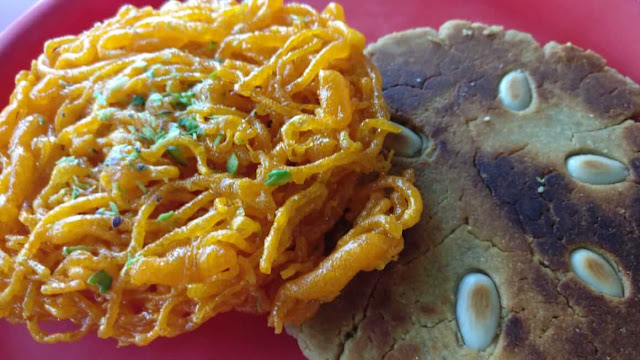- Get link
- X
- Other Apps
Posted by
Savita Paul
on
- Get link
- X
- Other Apps
Sindh, Sindhi and Khaado
If ‘Dumadum Mast Kalandar’ plays at any event, know that you are at a Sindhi event. You will witness a group of people merrily dancing to the song - with or without actually matching their steps to the beat - and chanting the chorus in union! This will be followed by pausing a few moments to catch their breath and perhaps even sit down to enjoy a bowl of Dahi Wada.
Sindhis are known for their joyous outlook towards life, being smart when it comes to business dealings (way off from the stereotypical tagline of ‘Chindi Sindhi’ meaning stingy with money) and a great amount of love for food. The traditions and customs are infused with those who have had a great influence on their culture over the decades that have passed by.
Sindhi language is universally spoken by all those belonging to the community. It can be written in Gurmukhi (Sikh scripts), Khojki (Muslim Shia Ismaili literature), Arabic (Persian alphabets that are still in use in Pakistan), Gujarati (Kutchi scripts), Devanagari (Hindu scripts) and Roman Sindhi (contemporary Sindhi language used for texting on mobile phones). The beauty of the language can be expressed through Sindhi literature and poetry that prove how wonderful it can sound when you put them down in verses and texts. Sindhi poetry dates back centuries considering the language has its roots in the Indus Valley Civilization
The Sindhi community is believed to have its origin in the indigenous tribes of the Indus Valley Civilization, Mohenjo Daro being the largest settlement. Even the name ‘Sindhi’ is derived from Sindhu which was the local name of the Indus River. The civilization declined following the drying of the river Ghaggra. Eventually, the western regions, of what we know as Sindh today, came to be ruled by the Persians, Greeks, Kushans and even Alexander The Great before the Islamic rule finally laid their hands on the land. Sindh happens to be one of the earliest regions in yesteryear India that was influenced by the Islamic culture and is based on the doctrines of Sufi lifestyle; before Islam invasion, it was largely Hindu and Buddhist.
During the Partition of India, Sindh became a part of the newly-formed Pakistan and people were forced to migrate. Punjab turned out to be the greatest source of shelter and comfort and that is why the community is influenced by the Sikh culture - Sindhis visit and get married in a Gurudwara and Aloo Parathas are a popular breakfast option in many Sindhi homes.
When it comes to Sindhi food, it goes above and beyond Sindhi Kadhi, the steaming hot pot of gram flour, tomato and veggie goodness. Dishes such as Lolo, Sai Bhaji with Bhuga Chawar, Dal Pakwan and Tuk tend to tickle your palate and bring a smile to anyone’s face who indulges in this food. The cuisine has been influenced by a variety of cultures such as Islam, Sikhism and Hinduism. Where a group of Sindhis reside or come from greatly reflects in what they consume as part of their diet.
Winters mean it is time to enjoy that revered Lolo, Doda and Koki while Sindhi Mutton/Sindhi Kadhi and Rice is the quintessential Sunday lunch. Sindhis turn to lighter food preparations when summer finally sets in. Singhi Aloo in Tomato Rassa (Drumsticks & Potatoes in Tomato Curry), Mattha (Apple Gourd/Baby Pumpkin in Curd), Kadu Kairi Bhaaji (Pumpkin in a Raw Mango preparation) and Phote Wala Mutton (Mutton cooked and served in a Pepper Broth) are popular choices to beat the heat.
For the sweet course, there is only one name that stands out - GHEER. Consider it a Sindhi version of a Jalebi, Gheer is most enjoyed during Holi (our mouth waters up simply thinking about it). Apart from Gheer there is Sheer Khurma or Kheer, Singar Ji Mithai (Sev Barfi) and other desserts that are specific to a family or a Sindhi community residing in a particular area.
INGREDIENTS:
- 1 kg Curd
- 1/2 tsp Black Salt
- 400 gms Eggplant/Apple Gourd, boiled and chopped
- 1 tsp Mustard (Rai) Dal Powder
- 1/2 tsp Red Chilli Powder
- Salt as required
- Coriander, for garnish
METHOD:
1. Whisk the curd to a thick buttermilk consistency.
2. Add black salt, red chilli powder, mustard (rai) dal powder, chopped and boiled eggplant/apple gourd and salt as required.
3. Keep the dish overnight and let it ferment to get a slightly sour taste.
4. Keep in the refrigerator to cool. Garnish with coriander and its ready to serve!
Enjoyfood!




Comments
Post a Comment